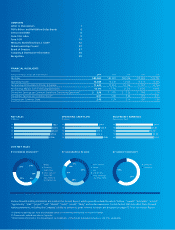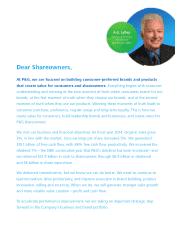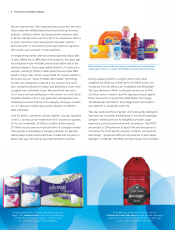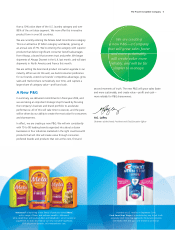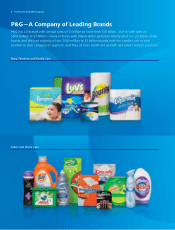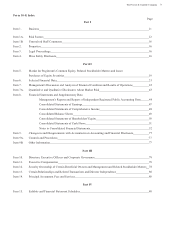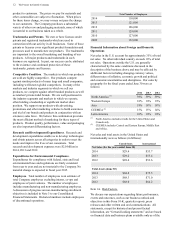Proctor and Gamble 2014 Annual Report Download - page 4
Download and view the complete annual report
Please find page 4 of the 2014 Proctor and Gamble annual report below. You can navigate through the pages in the report by either clicking on the pages listed below, or by using the keyword search tool below to find specific information within the annual report.
Joining Tide* and Ariel* in the unit dose laundry detergent
segment, one Gain Flings!* pac offers twice the cleaning
ingredients of one dose of original Gain liquid. Our unit
dose detergents span more than 50 countries worldwide,
with well over $1 billion in retail sales.
Head & Shoulders*
, the world’s #1 selling shampoo, has been
a leader for over 60 years with products such as Classic Clean
shampoo and conditioner. This year, we introduced Fresh Scent
Technology, which delivers an enhanced sensorial experience
without compromising superior scalp and hair care effi cacy.
A Focused Company of Leading Brands
P&G will become a simpler, more focused Company of to
brands, organized into about a dozen businesses and four
industry-based sectors. We will compete in businesses that are
structurally attractive and best leverage our core capabilities.
Within these businesses, we will focus on leading brands or
brands with leadership potential, marketed in the right countries
where the size of prize and probability of winning is highest,
with products that sell. We will discontinue or divest businesses,
brands, product lines, and unproductive products that are
structurally unattractive or that don’t fully play to our strengths.
Every brand we plan to keep is strategic, with the potential to
grow and deliver value creation. These core to brands are
leaders in their industries, businesses or segments. They offer
differentiated products and have a track record of growth and
value creation driven by product innovation and brand preference.
They generate nearly % of current P&G sales and more than
% of current profi t. They have grown sales one point faster,
with a higher profi t margin than the balance of the Company
during the past three years. The to brands we plan to exit
have declining sales of
−
%, declining profi ts of
−
% and half
the average Company margin during the past three years.
This strategic step will focus our innovation efforts, brand
building, and supply network on fewer, more important brands.
It will focus our selling resources on brands that really matter to
consumers and retail customers, on businesses where we know
how to win. It will provide consumers with a better shopping
experience by simplifying shelf sets. It will improve service and
growth for retail customers. All of these outcomes will accelerate
growth and value creation.
We will create a faster growing, more profi table Company that
is far simpler to manage.
A Far More Productive Company
As a result of the Company’s strategic focus on leading brands,
we will accelerate and over-deliver the original $ billion
productivity plan we announced in . We see signifi cant
savings potential ahead across all spending elements
—
cost of
goods sold, marketing spending, and overhead
—
for the next
several years.
In cost of goods sold, we are already achieving productivity
improvements beyond our original savings objectives. Better
manufacturing reliability and adherence to quality standards are
resulting in less raw material usage and reduced fi nished product
scrapping. Increasing localization of the supply chain is driving
savings in transportation and warehousing costs.
Earlier this year, we initiated what is probably the biggest
supply chain redesign in the Company’s history, starting in
North America. We’re moving from primarily single-category
production sites to fewer multi-category production plants.
We’re simplifying, standardizing and upgrading manufacturing
platforms for faster innovation, qualifi cation and expansion,
and improved product quality.
We’re transforming our distribution network, starting with
North America. We’re moving from shipping products to retail
2 The Procter & Gamble Company


